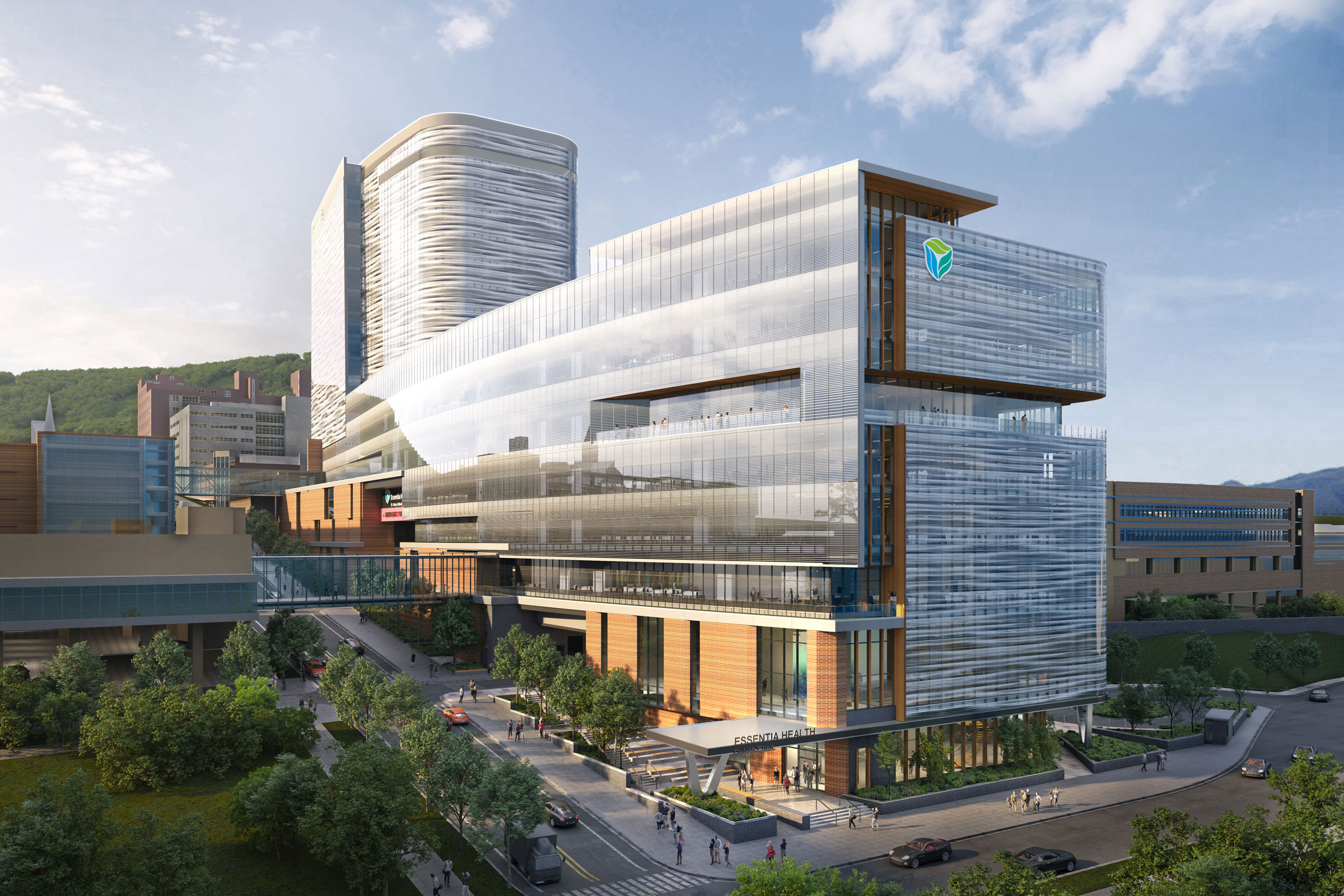Story at a glance:
- Sustainable health care design aims to emphasize healthy, efficient, and environmentally friendly health care facilities.
- Daylighting, energy-efficient systems, and inclusion of green spaces, all lead to more sustainable health care designs.
- The Taussig Cancer Center, Rancho Los Amigos Recuperative Care Campus, and Cedars-Sinai Los Feliz Urgent Care Clinic are a few examples.
The health care sector accounts for approximately 4.4% of the world’s annual greenhouse gas emissions and 8.5% of the greenhouse gas emissions in the United States—and that’s to say nothing of health care’s contribution to waste production, resource extraction, and water usage.
Improving the sustainability of our health care facilities is not only imperative to addressing climate change, but it also helps create healthier, more productive societies that are better suited to providing accessible, equitable health care to all persons.
These are the basics of sustainable health care design, including strategies for implementation, metrics for measuring sustainability, and a few examples of successful, sustainable health care projects from around the country.
What is Sustainable Health Care Design?
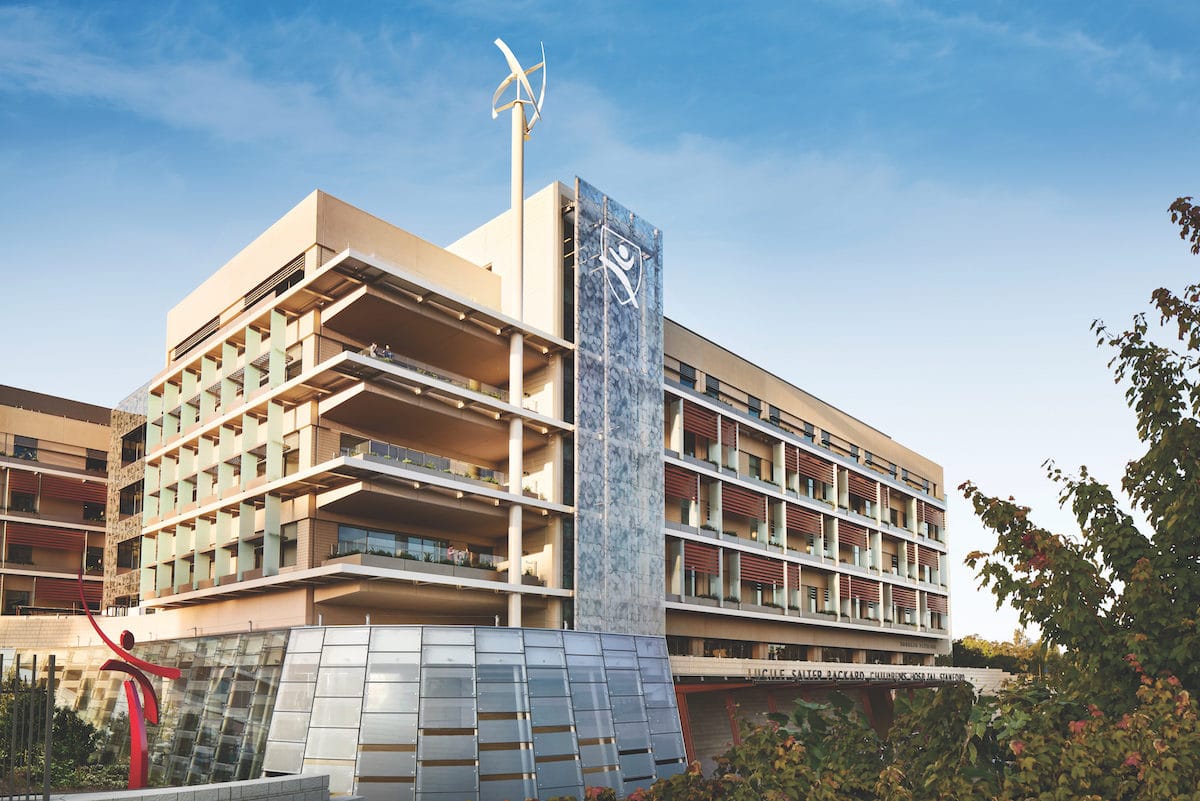
Lucile Packard Children’s Hospital was designed by Perkins&Will to be as sustainable as possible. Photo by Steve Babuljak
Sustainable health care design is best understood as an offshoot of the sustainable architecture movement dedicated to the design and construction of efficient, healthy, environmentally friendly health care facilities whose operations have a positive impact on people, society, and the planet as a whole.
The American Hospital Association defines sustainability in health care as the “integration of environmental stewardship, social equity and fiduciary responsibility to support healthy, equitable and resilient environments and communities over time.” Sustainable health care design ultimately aims to minimize the health care sector’s negative environmental impacts while maintaining and improving the health and well-being of both contemporary and future generations.
The Importance of Sustainability in Health Care
Aside from the fact that sustainable design in general is crucial to addressing anthropogenic climate change, integrating sustainability into the design of our health care facilities is important for a number of reasons, including:
Reduced Emissions & Operating Costs
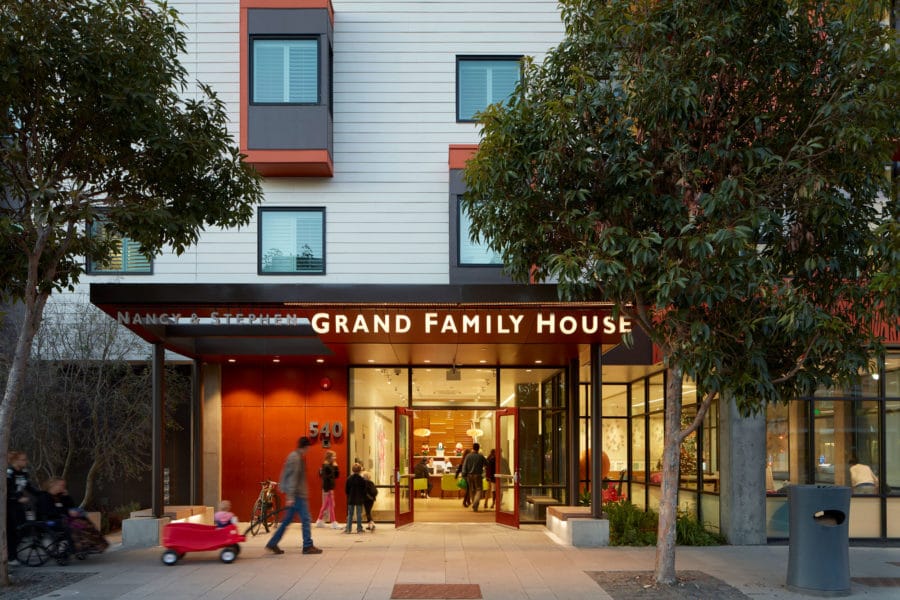
Designed by Leddy Maytum Stacy Architects, the Family House employs a variety of strategies to reduce energy consumption and operates 48% more efficiently than comparably-sized facilities. Photo by Bruce Damonte
Health care facilities that implement sustainable design strategies focused on reducing energy consumption—such as daylighting, natural ventilation, use of renewable energies, et cetera—predictably generate fewer greenhouse gas emissions than those designed to conventional building standards.
GHG emissions and burning fossil fuels are the leading contributors to climate change, which is in and of itself a threat to public health and safety. By reducing emissions and investing in green energies, sustainable health care facilities help combat air pollution, address the impending climate crisis, and lower their operating costs.
Healthier Indoor Environments

The Jack Byrne Center for Palliative & Hospice Care prioritized sustainable, non-toxic materials to create a healthy indoor environment for patients. Photo courtesy of E4H Environments for Health Architecture
Sustainably designed health care facilities help create healthier indoor environments in a number of ways, including:
- Daylighting. Exposure to natural sunlight is key to maintaining the body’s natural circadian rhythm, strengthens the immune system, lowers blood pressure, improves brain function, and more.
- Natural ventilation. Breathing fresh air helps clean the lungs, improves heart health, boosts brain health, facilitates healthy digestion, and more.
- Energy Recovery Ventilation. ERV technology helps maintain stable humidity levels and reduces the likelihood of dry skin, dry eyes, coughing, and other symptoms caused by overly-dry air-conditioned air.
- Green building materials. Use of non-toxic materials reduces exposure to VOCs and other potentially dangerous chemicals that may cause respiratory issues or even certain cancers.
- Built-in antimicrobials. Products and materials that use built-in antimicrobials keep spaces cleaner and help prevent mold, mildew, and bacteria growth, reducing the spread of germs and even some viruses.
Together these strategies help health care workers do what they do best and provide patients with the peace of mind that they are receiving the best care possible.
Lower Environmental Impact
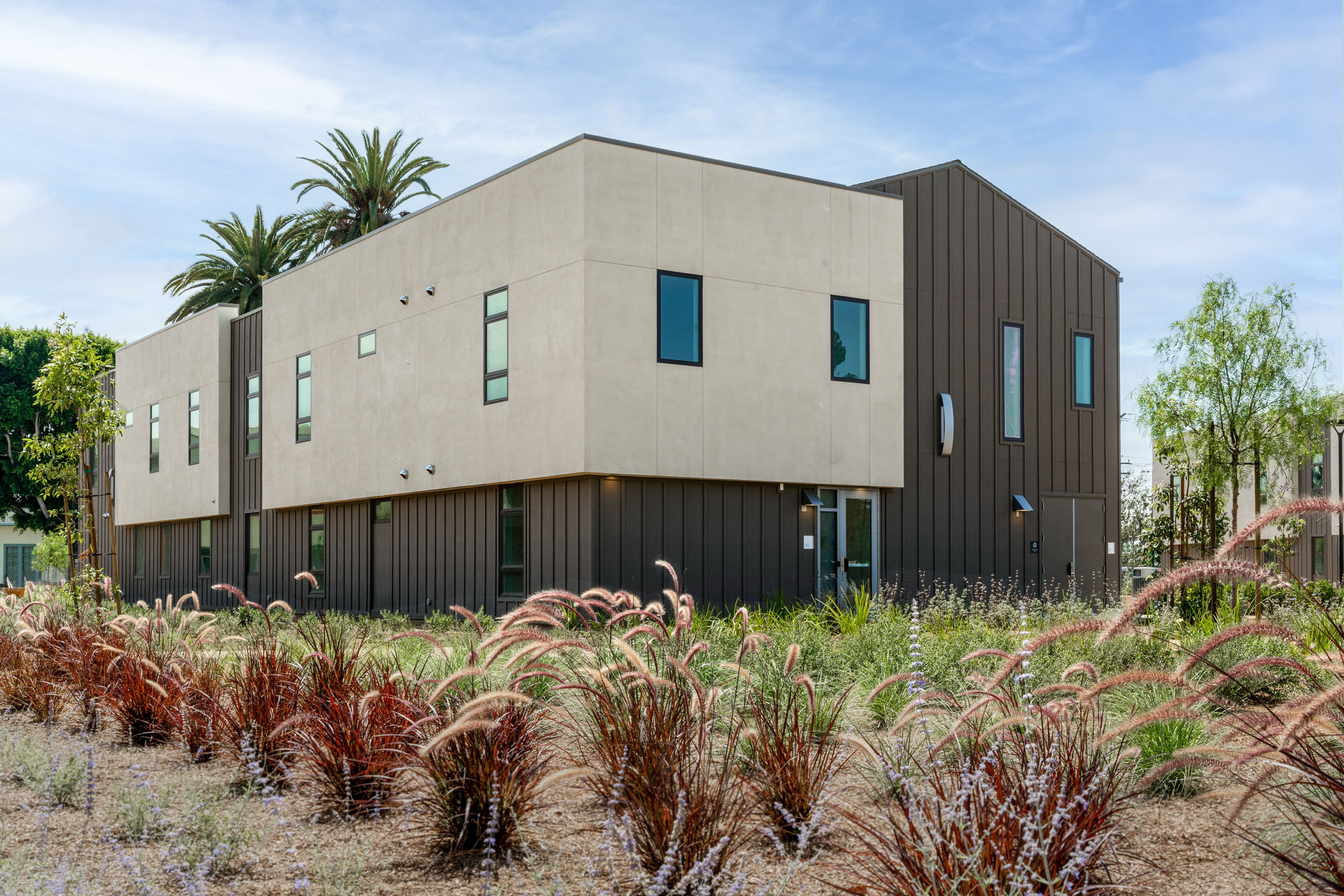
The 6.8-acre Rancho Los Amigos Recuperative Care Campus was designed around the landscape, with drought tolerant native plants helping to restore the natural habitat. Photo by Ric Berryman
In taking measures to reduce their energy consumption, water use, and waste production, sustainable health care facilities lower their overall environmental footprint and do less damage to the natural world.
This is especially true of health care facilities that integrate green spaces and effective stormwater management into their designs, as features like green roofs and bioswales can actually help foster biodiversity and maintain crucial ecological processes.
Strategies for Sustainable Health Care Design
Sustainable health care design takes many forms and can manifest in a variety of ways. Some of the most common strategies include:
Daylighting

Perkins&Will designed Hope Lodge as a sanctuary for cancer patients and their families, with plentiful light and areas that feel like home. Photo by James Steinkamp
While it may not be possible to illuminate every room in a health care facility with natural light, special care should be taken to include daylighting solutions—such as large windows, skylights, light tubes, et cetera—wherever possible. “Exposure to natural light has been proven time and time again to have numerous benefits for people, from visual comfort to psychological and neurological benefits like improving mood, reducing stress, enhancing the body’s immune response, and allowing for better sleep,” Tori Wickard, senior project architect at Perkins&Will, previously told gb&d.
Studies have even shown that patients who are treated in facilities that prioritize daylighting over electric lighting heal faster and experience less pain, resulting in shorter hospital stays and quicker recovery times.
In addition to the physiological benefits that come from daylighting, natural sunlight also renders colors more faithfully than artificial light, making it easier for health care workers to accurately evaluate patient health. “Natural light renders color much differently,” Kevin Mereness, interior design principal at Perkins&Will in Dallas, previously told gb&d. “As they look at their skin and evaluate their health, being able to see more accurately for diagnosis is very important. There can be opportunities where they’re not just under a lamp but in spaces that have some controlled amount of natural light that can get you a better opportunity for a more accurate diagnosis.”
Energy-Efficient LED Lighting
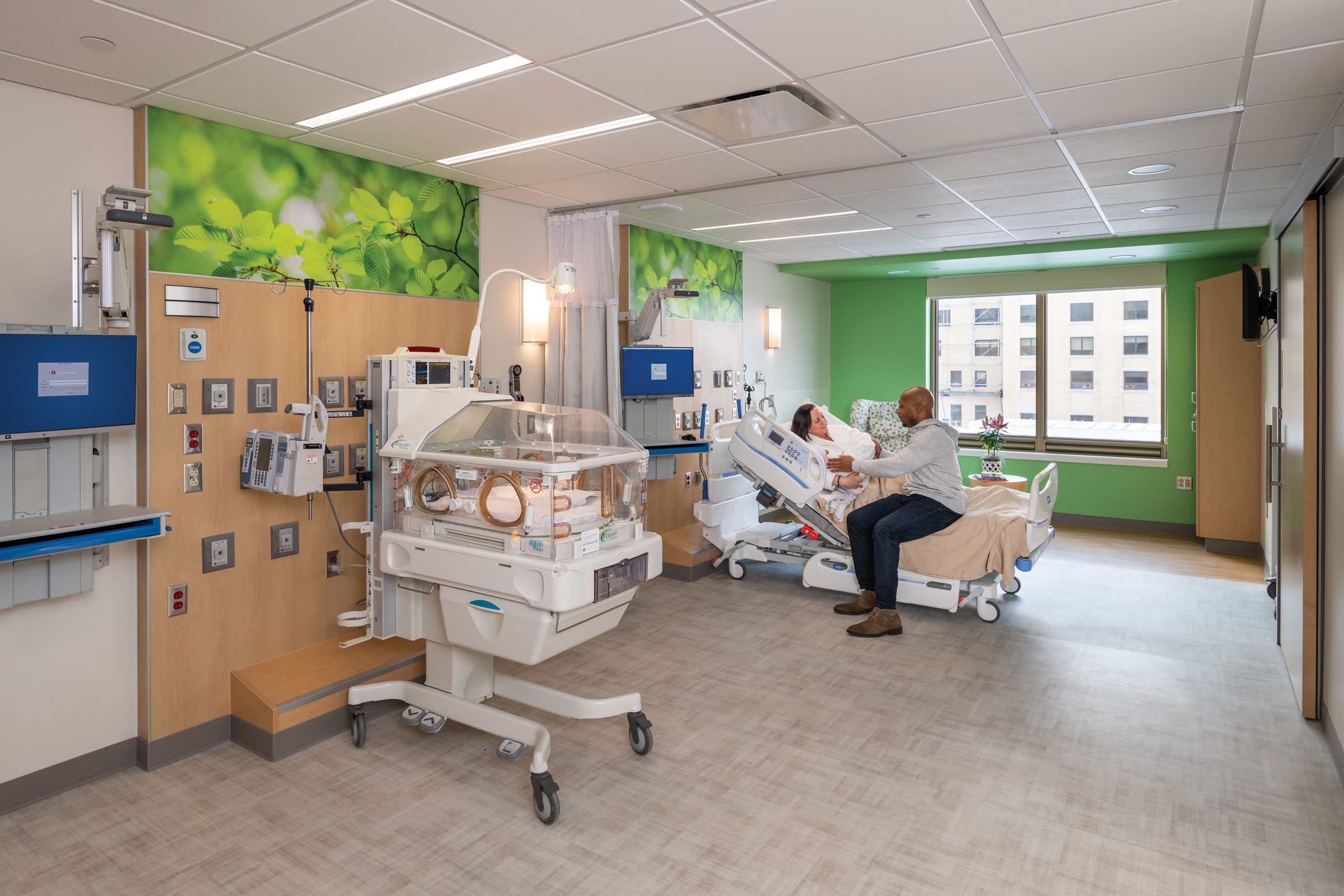
Lenga is seen at the HSHS St John’s Children’s Hospital NICU, designed by Kahler Slater. Lenga is a tandem-mounted overbed light with multiple light modes for patient comfort. Photo by Peter McCullough
In areas where daylighting strategies are impossible or not feasible to implement—such as inside operating rooms—LED lighting should be prioritized in order to reduce energy consumption. Compared to traditional fluorescent or incandescent bulbs, LEDs use 90% less electricity, produce almost no heat, and have much longer lifespans.
Because they come in a wide variety of colors, wavelengths, and lighting temperatures, LED lights also offer a more sophisticated level of control that allows them to mimic the circadian impact and psychological effect of natural light better than incandescent and fluorescent bulbs.
Visa Lighting is a leading manufacturer of beautiful, high-performance light fixtures and offers a variety of products designed especially for use in health care facilities. Visa Lighting’s Lenga model, for example, is a tandem-mounted overbed light that features multiple modes—including directional exam lighting, higher intensity reading illumination, and soft ambient lighting—for caregiver efficiency and patient comfort. Lenga can be specified with traditional white LED sources or tunable sources optimized for circadian lighting.
In addition to being energy-efficient, Visa Lighting’s products are also designed to be as non-institutional as possible in order to create a pleasant, welcoming, and dignified health care environment. “Our goal has been to combine the decorative design elements with performance and other technical requirements,” Hans Nielsen, senior industrial designer at Visa Lighting, previously told gb&d.
Solar Shading
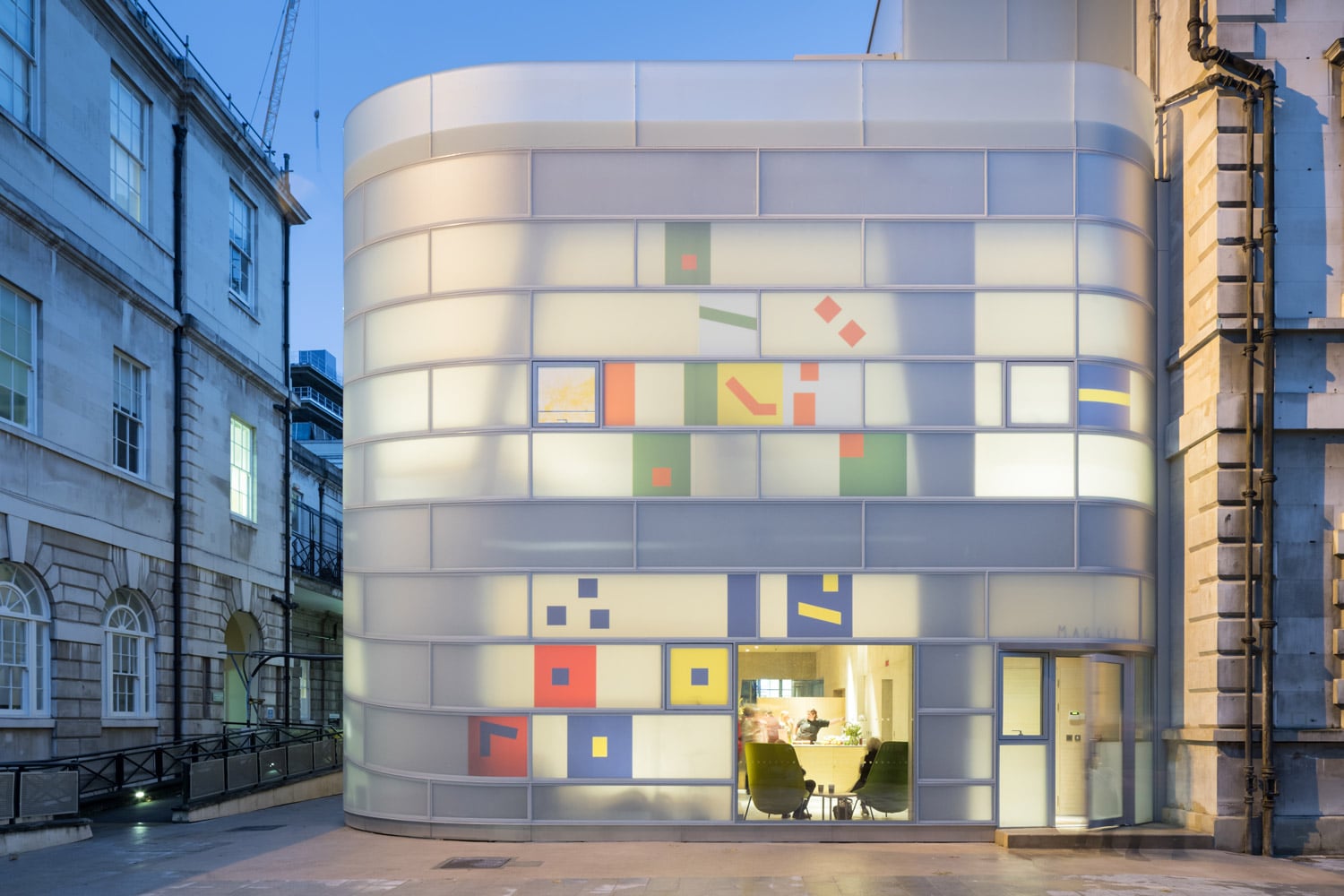
The exterior of Maggie’s Centre Barts in London is clad in polychrome insulating glass that serves to maximize natural light while minimizing unwanted solar gains. Photo courtesy of Steven Holl Architects
Just as important as daylighting, however, is solar shading. Solar shading refers to those features used to optimize the amount of solar heat energy that enters a building. Effective solar shading devices serve to block solar heat gain during the hottest months of the year (to prevent overheating) while still allowing sunlight to enter during the coldest months in order to exploit its thermal properties and reduce mechanical heating loads.
Solar shading devices can be described as either fixed (stationary) or dynamic (movable). Fixed solar shading is the simpler of the two and includes:
- Awnings and canopies
- Overhanging eaves and balconies
- Light shelves
- External louvers and brise soleil
- Deciduous trees
Dynamic shading, on the other hand, encompasses elements like:
- Internal and external shutters
- Internal blinds and curtains
- External blinds or screens
- Adjustable shading devices
When implemented correctly, dynamic shading strategies offer a greater amount of control over solar heat gain admittance. Many dynamic shading solutions can even be motorized or automated to respond to external weather conditions.
Natural Ventilation
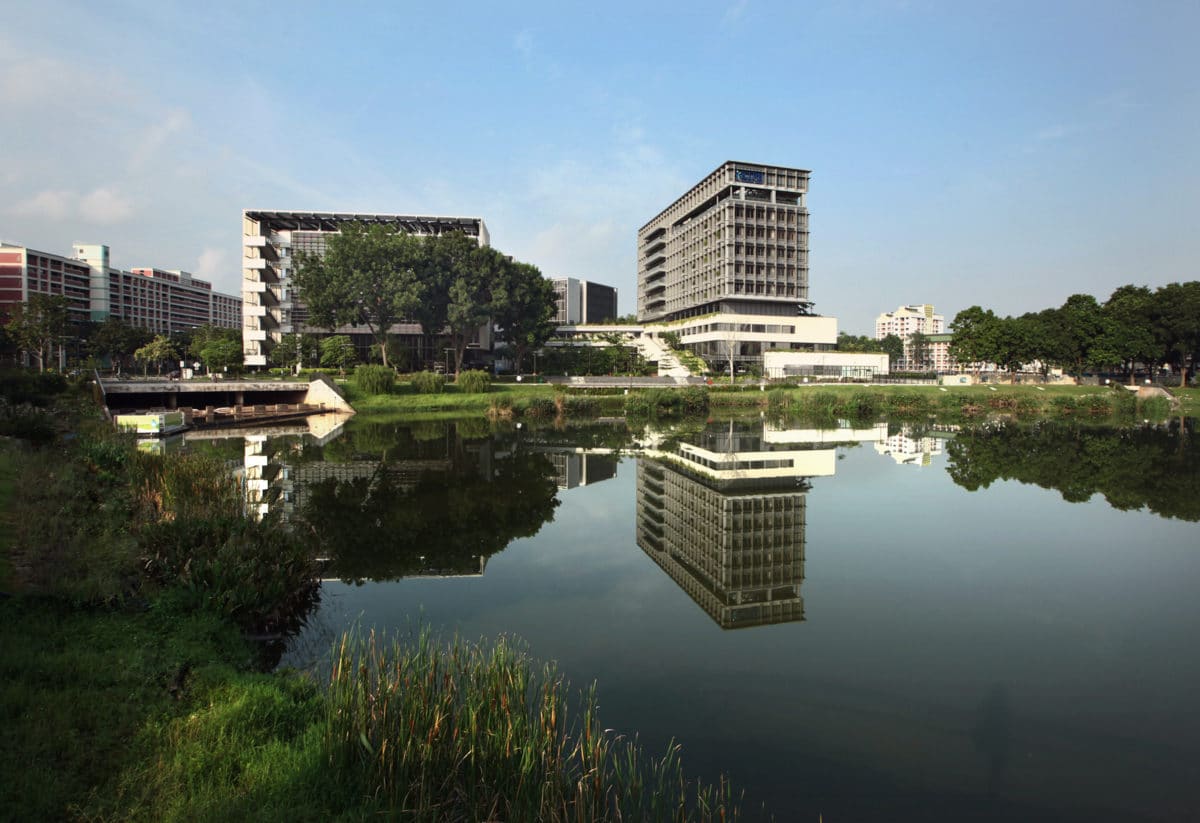
Khoo Teck Puat Hospital was oriented so as to make effective use of prevailing North and South East winds for natural ventilation. The hospital’s V-shaped footprint also opens up to a nearby stormwater pond that supplies the building with cool breezes during the day. Rendering courtesy of the International Living Future Institute
Mechanical HVAC systems can help circulate air throughout a building, but they don’t always do a great job of expelling pollutants, and they often create stale indoor environments. Natural ventilation systems, on the other hand, pull in fresh air, circulate said air, and then remove that air in a continuous cycle driven by the volumetric pressure differences caused by either wind or buoyancy.
Exposure to fresh air increases the body’s intake of oxygen and is known to have a positive effect on both physical and mental health by sharpening one’s focus, lowering heart rate, and even improving digestion.
The possibilities of natural ventilation in health care design are exemplified by Khoo Teck Puat Hospital (KTPH) in Singapore, whose footprint is optimized for making effective use of natural airflow. Designed by Robert Matthew Johnson Marshall Architects in collaboration with CPG Consultants, KTPH’s ward tower is oriented so as to make the most of prevailing North and South East winds, reducing mechanical ventilation loads by 65%.
Energy Recovery Ventilation

Santa Clara Valley Medical Center’s Sobrato Pavilion uses a 100% outdoor air heat recovery ventilation system to supply the interior with fresh air. Photo by David Wakely
Natural ventilation isn’t always possible—especially for health care facilities in dense urban areas with higher concentrations of outdoor air pollutants. But that doesn’t mean there aren’t other ways to sustainably improve ventilation and indoor air quality for patients and health care workers while at the same time reducing energy consumption. High-efficiency HVAC systems, for example, may be outfitted with energy recovery capabilities to recover and reuse waste heat that would otherwise be exhausted from the building.
Energy recovery ventilation (ERV) systems are incredibly efficient and are typically capable of recovering anywhere from 60 to 95% of the heat from incoming or outgoing air. During warmer months an ERV unit will recover heat from the incoming air and direct it back outside, dehumidifying the air in the process; in winter an ERV recovers heat from the outgoing air and reuses it to help warm the incoming air, which is then humidified before it is circulated.
A ventilation system with balanced heat recovery ensures that a building always receives plentiful, nearly room temperature fresh air year-round and helps maintain desirable indoor relative humidity levels, making for a much more comfortable indoor environment and drastically improving indoor air quality.
Use of Low VOC & Nontoxic Materials
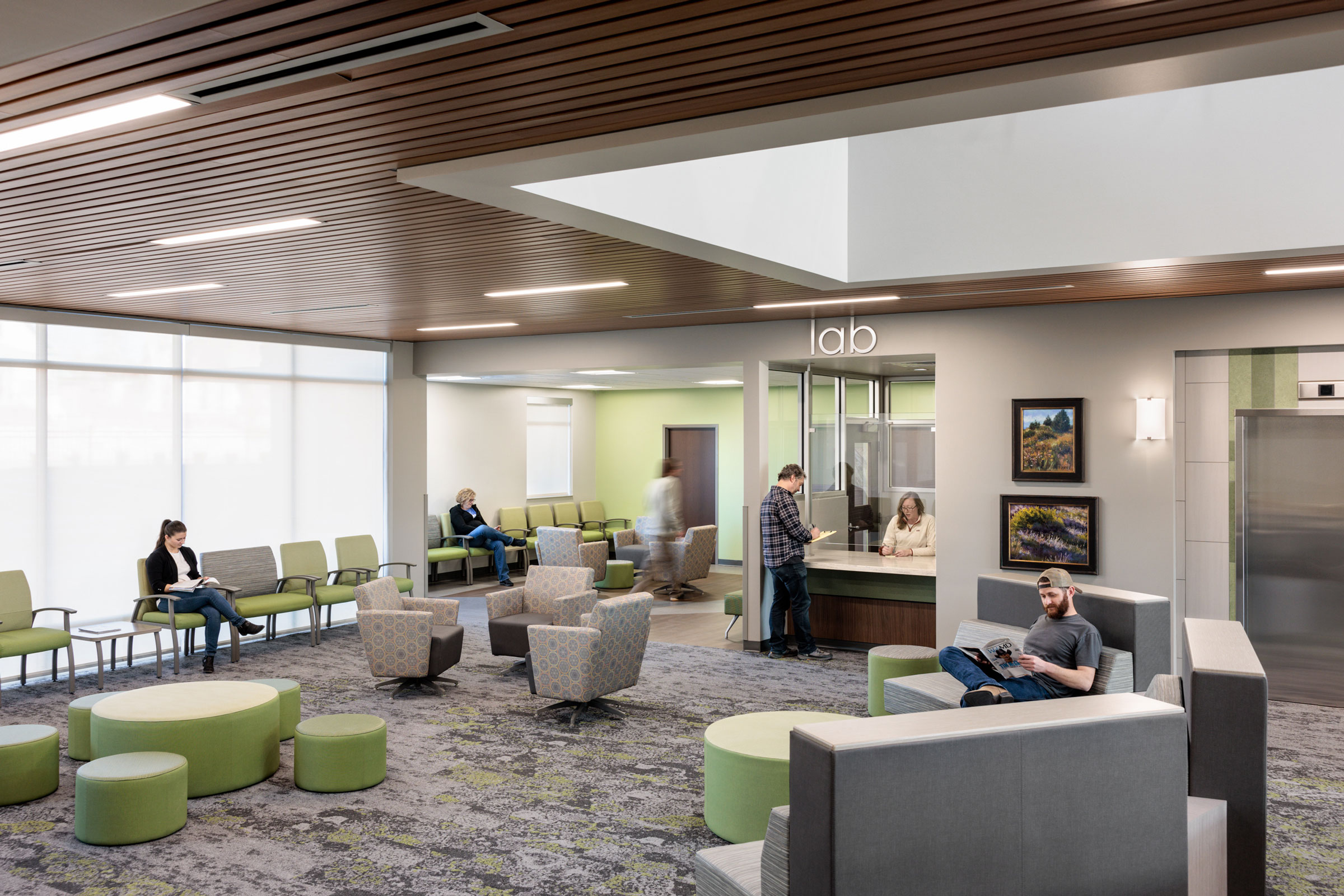
Mohawk Group’s Lichen flooring was designed by Jason F. McLennan, the founder of the Living Product Challenge, and is the first floor covering to achieve Living Product Challenge Petal Certification. Photo by David Lauer Photography
Sustainable health care design also places a high priority on using nontoxic, low-VOC materials and products in place of mass-produced, non-renewable building materials. These materials tend to have lower embodied carbon, create fewer GHG emissions during their procurement, processing, and manufacturing, and do not leach as many harmful chemicals or compounds into the air over time.
“We define wellness as a state of being and a process that aims to achieve a whole person’s health, or in this case, a patient’s,” Maria Papiez, director of sustainable design for EwingCole, previously wrote for gb&d. “To support that process, optimizing the materials surrounding patients and making up the indoor environment is the highest priority.”
To ensure the environment is as healthy and patient-friendly as possible, many sustainably designed health care facilities take care to prioritize materials and products bearing the Red List–free label. The International Living Future Institute’s Red List is a comprehensive guide to the “worst in class” chemicals, materials, and elements known to cause serious harm to human and ecosystem health. Red List–free products fully disclose 100% of their ingredients at or above 100 ppm in the final product and do not contain any chemicals on the Red List.
Mohawk Group, for example, is a leading producer of sustainable flooring solutions and offers a wide selection of products that meet the rigorous requirements of the Living Product Challenge—that is, they are Red List-free, net-positive in both carbon and water, and are manufactured in a way that prioritizes human and environmental health. Many of Mohawk Group’s products, like their Lichen collection, are inspired by nature and also serve a biophilic role, grounding spaces in the natural world and creating more comfortable, welcoming health care environments.
“A lot of times you’re interacting with these spaces on what could possibly be some of the worst days of your life,” Elizabeth Bonner, director design segment at Mohawk Group, previously told gb&d. “If you can provide a touch of comfort on those days, it makes a big difference.”
Built-In Antimicrobial Design

Built-in antimicrobials can help health care facilities meet economic, social, and environmental sustainability goals. Creating products that inherently resist microbial growth translates to products, surfaces, and environments that last longer and require less maintenance and repair. Photo courtesy of Microban
A defining characteristic of any health care facility is its ability to provide a clean, sterile environment for both workers and patients. Maintaining such an environment, however, necessitates frequent cleaning, often using very strong chemical cleaners that can actually reduce the lifespan of various products and building materials—and that’s to say nothing of the damage microbes themselves can cause. Fortunately, there are ways to incorporate antimicrobial qualities into materials themselves, reducing the amount of cleaning required.
Microban is the world’s leading embedded antimicrobial ingredient brand and an industry pioneer that specializes in the creation of cleaner, fresher, and more durable products that provide 24/7 protection against mold, mildew, bacteria, and even some virus strains. “By keeping products and surfaces cleaner, built-in antimicrobial solutions deliver added peace of mind for health care workers and patients,” Michael Ruby, president at Microban, previously told gb&d. “These technologies should also be considered for products that can replace single-use items and those that are harder to keep clean.”
Health care products that feature Microban’s antimicrobial technology—such as bedpans, privacy curtains, pillows, and even carpets—are capable of resisting degradation caused by microbial growth for their entire lifespans, making them much more durable and long-lasting. “When we extend the life of a product we are reducing landfill loading. We’re reducing the need for repurchase and replacement,” says Ruby. And because they require less frequent cleaning/washing, surfaces that utilize built-in antimicrobials can also help health care facilities reduce their water consumption as well as waste production.
Renewable Energy Production
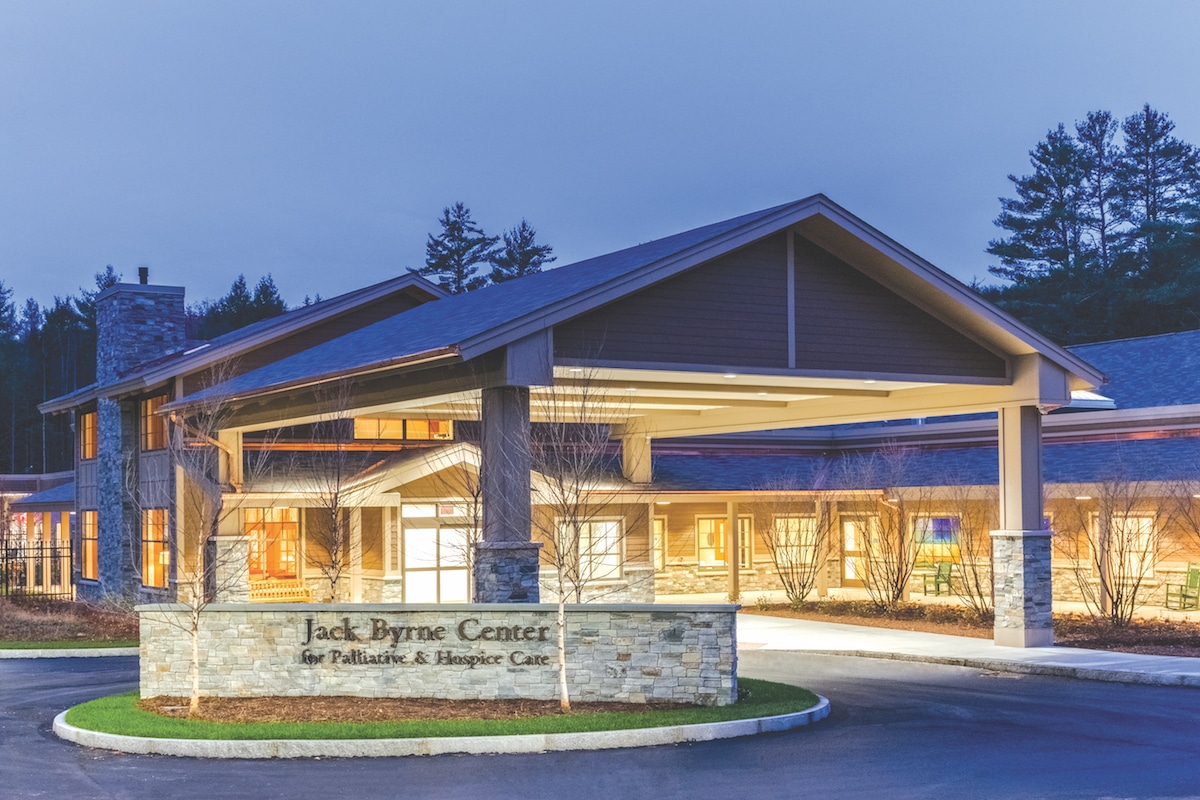
The Jack Byrne Center for Palliative & Hospice Care relies on a geothermal heating and cooling system. Photo courtesy of E4H Environments for Health Architecture
Integrating renewable energy sources into health care design is a growing trend, especially when it comes to solar power. Many health care facilities are multi-story constructs built in highly-urbanized areas that receive minimal shade throughout the day, making them ideal candidates for the installation of rooftop solar panels or photovoltaic arrays. These can help facilities offset their carbon emissions and reduce operating costs.
Another renewable energy source that more and more health care facilities are embracing is geothermal power. The Jack Byrne Center for Palliative & Hospice Care in Lebanon, New Hampshire, for example, utilizes a geothermal heating and cooling system in conjunction with a back-up energy-efficient gas boiler to reduce its energy consumption.
Flexible & Adaptable Floor Plans

UCLA Health’s Calabasas facility was intentionally designed with flexible, adaptable floorplans to accommodate easy room conversions. Photo courtesy of UCLA Health
In anticipation of future growth and reconfiguration, many modern health care facilities are designed with flexible, adaptable floor plans that allow for rooms to be changed around or repurposed without requiring a complete renovation.
UCLA Health’s Calabasas Campus, for instance, utilizes the same basic footprint for a variety of rooms to ensure spaces may be reorganized or rearranged in the future with relative ease. “After construction, whether one’s an exam room with an exam table and a hand-washing station or one has more furniture, we allow for flexibility along the way so if we determine we really need more exams than consults, we can convert that room easily,” Amy Kraft, director of UCLA Health Real Estate Planning, Design & Construction, previously told gb&d.
By designing for flexibility from the outset, hospitals and other health care facilities are able to extend their lifespan and reduce the amount of construction waste generated over the building’s operational life cycle.
Water Conservation & Management

The VA Puget Sound Mental Health & Research Building uses rainwater to flush toilets and practices sustainable stormwater management strategies. Photo by Ben Benschneider
Water used by hospitals and other health care facilities accounts for approximately 7% of all water used by institutional and commercial facilities in the United States. To help reduce water consumption health care facilities can install low-flow—such as those bearing the WaterSense label—and water-efficient appliances, incorporate recycled rainwater, and make green plumbing decisions.
In addition to employing effective water conservation measures, health care facilities can also make use of effective water management systems—like bioswales—that help mitigate stormwater runoff, reduce the risk of urban flooding, and recharge groundwater reservoirs.
The Stantec-designed VA Puget Sound Mental Health & Research Building in Seattle, for example, collects rainwater from its three green roofs to be reused in flushing the building’s toilets and employs ground-level stormwater management practices to reduce the flow-rate of runoff. “In the landscape out on the site there are bioswales and various means of dumping the water into the landscape, rather than sending it into storm drains and making it Seattle’s issue,” Ian Lawlor, project director at Stantec, told gb&d in a previous article. “We use very efficient irrigation systems to reduce the amount of water that we’re spreading into the landscape.”
Green Spaces & Vegetation
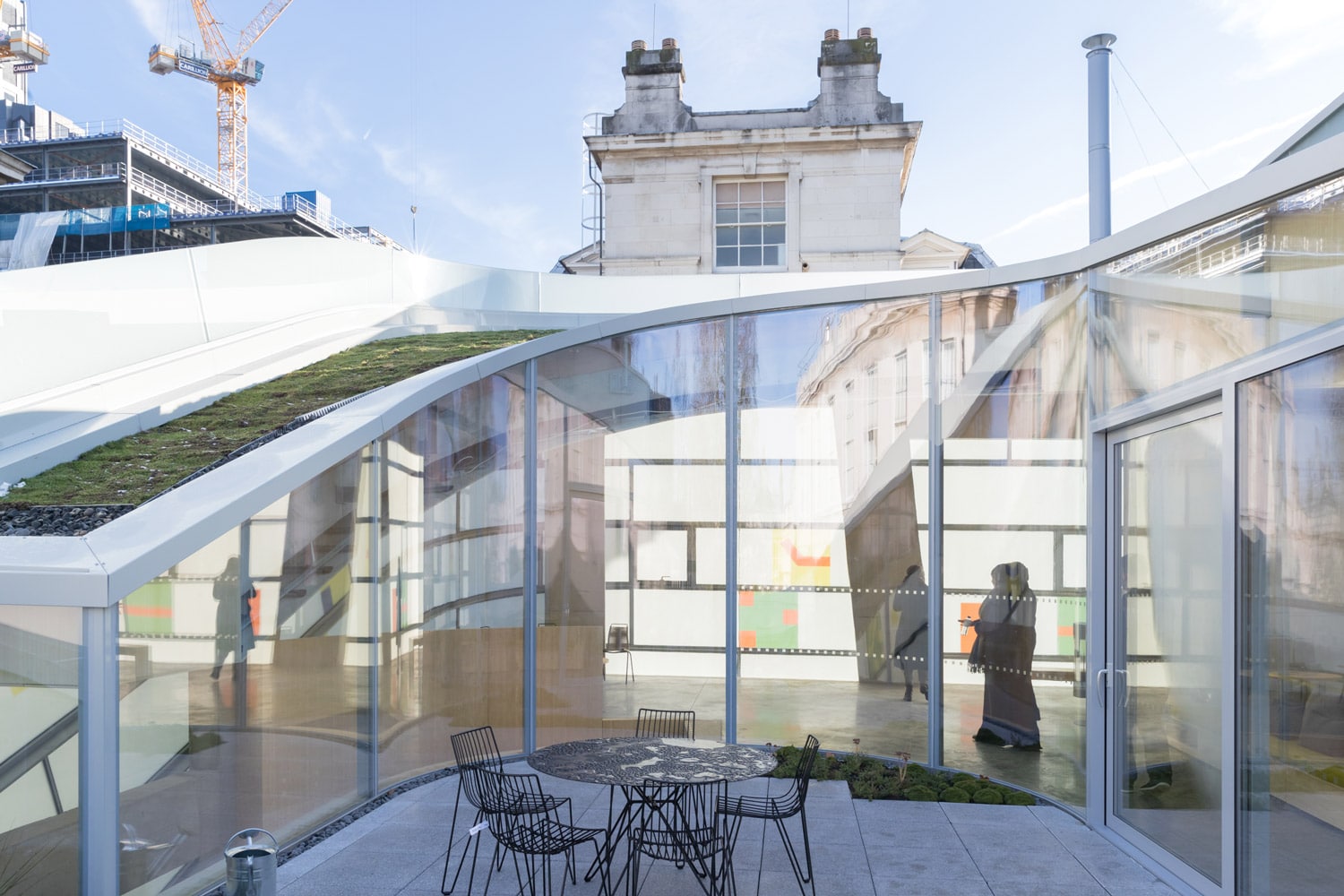
Maggie’s Centre Barts’ green roof and terrace provides cancer patients with a tranquil space to relax and practice mindfulness activities amidst London’s hustle and bustle. Photo courtesy of Steven Holl Architects
Providing patients and medical workers with places to connect with the outdoors is a growing trend in sustainable health care design. Gardens, terraces, accessible green roofs, and other green spaces invite patients, their families, other visitors, and staff to access fresh air and interact with the natural world in a more intimate manner. Studies show that access to these sorts of green spaces—even just a visual connection—can improve psychological health and reduce stress, which in turn helps patients recover faster and makes hospital employees more productive.
Maggie’s Centre Barts in London, for example, was designed by Steven Holl Architects to include a green roof and rooftop terrace to give cancer patients spaces for yoga, meditation, and other mindfulness activities. “There are not just ecological advantages to having a green roof; it is also a nice thing for the user,” Dominik Sigg, associate at Steven Holl Architects, previously told gb&d. “The roof is on a slope so you can see it from the vantage point of the terrace, and it becomes part of the garden.”
Features like green roofs and green facades also help provide natural cooling by way of evapotranspiration, improve outdoor air quality, increase biodiversity, and reduce the flow-rate of stormwater runoff.
How to Measure Sustainability in Health Care Design
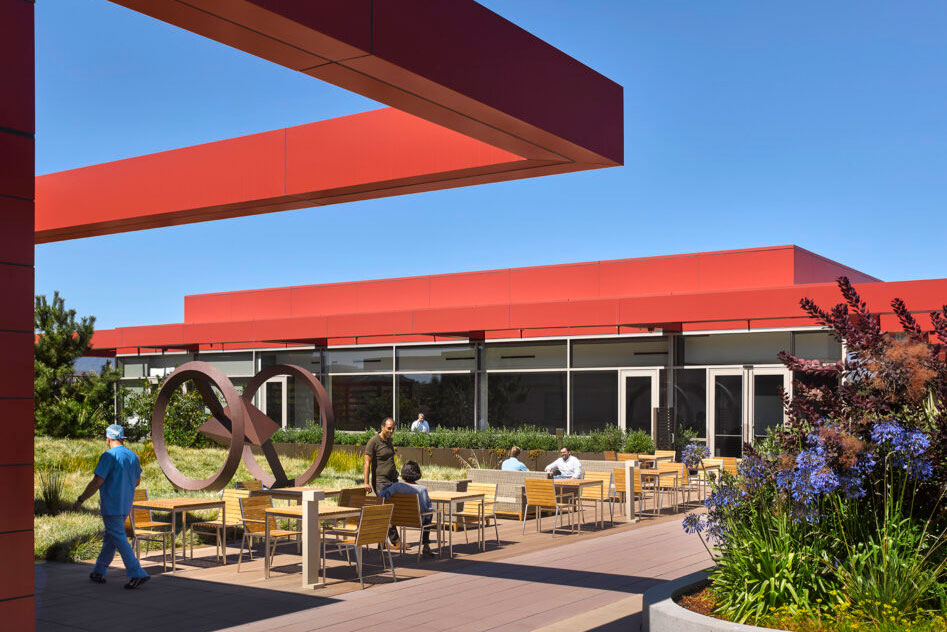
The third floor garden area at the new Stanford Hospital provides a place of respite. Photo by Will Pryce
Measuring sustainability in any form of architectural design is a bit complex, as certain metrics—such as energy use, water use, renewable energy production, et cetera—require long-term monitoring before definitive performance measurements can be calculated.
In general, the following methods and metrics are used to measure and quantify the sustainability of health care facilities:
- Life-Cycle Assessment (LCA). This particular tool utilizes scientific principles and methods to evaluate a product or built structure’s environmental impact over the course of its entire life-cycle, from extraction of materials and construction to use and eventual demolition or recycling; considered to be one of the most effective strategies for measuring sustainability.
- Life-Cycle Costing (LCC). Similar to an LCA, LCC analyses consider all of the costs incurred during a building’s lifetime and are used to measure a project’s fiduciary sustainability.
- ASHRAE Guideline 14. A standardized set of energy, demand, and water savings calculation procedures used to measure and report building performance.
- Post Occupancy Evaluation (POE). Process typically conducted six months to a year after a building’s occupation that analyzes in-use performance data against in-design specifications; valuable in identifying improvement areas and bettering future designs.
4 Examples of Sustainable Health Care Design in Practice
Here are a few inspiring examples of sustainable health care design from around the world.
1. Rancho Los Amigos Recuperative Care Campus, Downey, CA

Photo by Ric Berryman
In Downey, California, GGA+ designed Rancho Los Amigos Recuperative Care to LEED Gold standards. The campus serves the greater Los Angeles County community by providing physical rehabilitation services in a mindful, sustainable manner. The 6.8-acre, park-like property includes a central Recuperative Care Center, five residential treatment program buildings, and several outdoor healing spaces.
“Conceptually the GGA+ team referenced a farming village as a site planning prototype appropriate to the history and culture of the campus,” Staci Nesbitt, principal architect at GGA+, wrote in a previous gb&d article. “Respecting the rich context of existing mature trees at the site, the proposed plan created an informal and organic organization of the buildings and associated outdoor spaces.”
Because California frequently experiences droughts and prolonged dry spells, Rancho Los Amigos makes use of drought tolerant landscaping to drastically reduce its irrigation needs and overall on-site water requirements. The few grass lawns that the campus does possess are watered by a gray water recycling system, while remainder of the property features hardscape elements and pollinator gardens seeded with native plants.
“A series of outdoor spaces for intimate social interaction and light activities like gardening and grilling can be found within these pollinator gardens,” writes Nesbitt. “Existing large tree specimens were preserved onsite, with training in tree trimming, care, and maintenance central to this restorative landscape and woven into the residents’ daily routine.”
Rancho Los Amigos also employs a variety of other sustainability features that reduce its energy needs, including prefabricated wall panels with high levels of insulation, energy-efficient siding and windows, reflective roofing PVC, high-efficiency VRG mechanical systems, advanced building-level energy metering, and the production of onsite renewable energy via a photovoltaic panel array.
2. Cedars-Sinai’s Los Feliz Urgent Care Clinic, Los Angeles
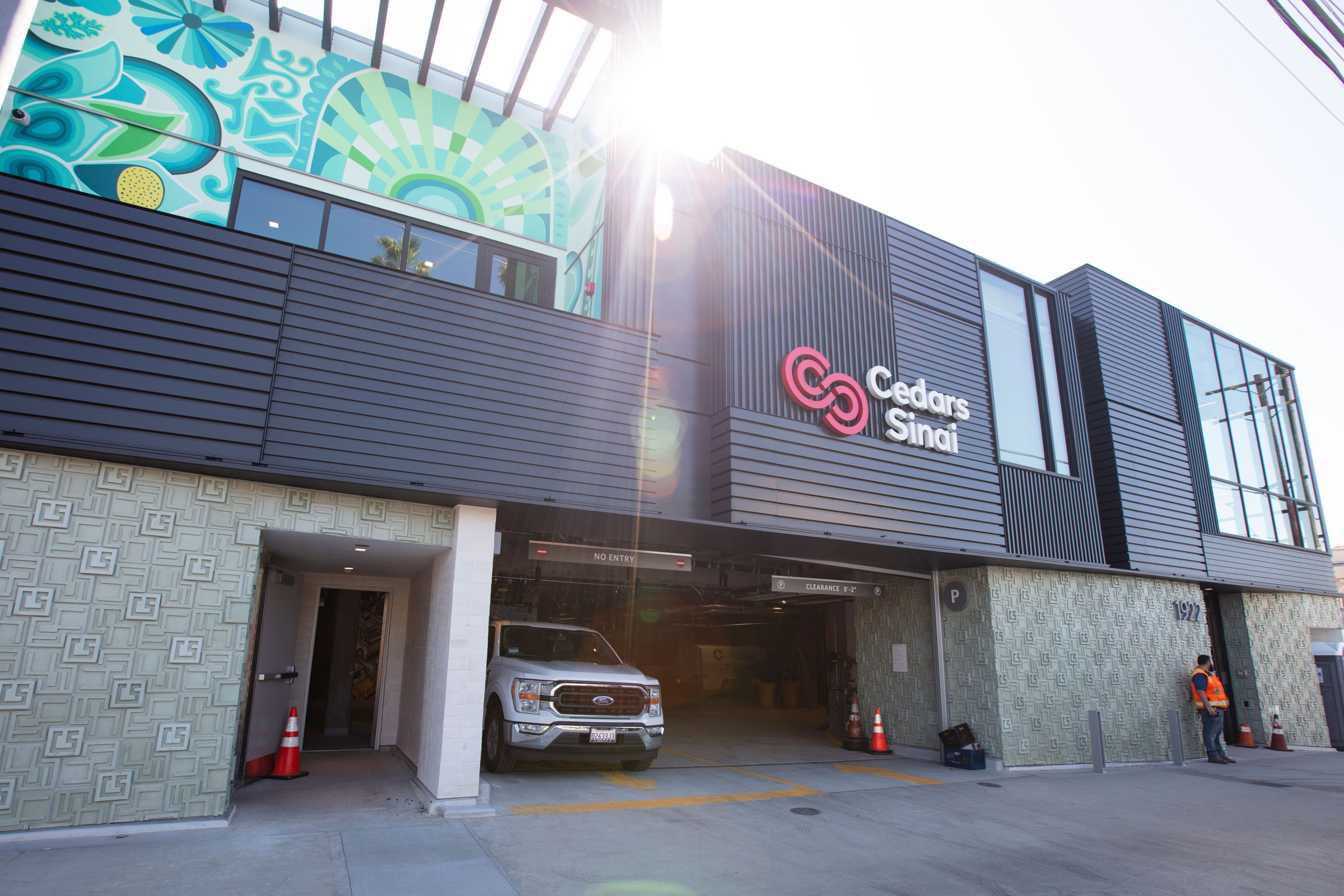
A new urgent care facility in the Los Feliz/Silver Lake area has a mural from a local artist inspired by the indigenous people who lived there and the local flower marts. Photo courtesy of Cedars-Sinai
Designed by Abramson Architects, this new Cedars-Sinai Urgent Care Clinic takes design inspiration from the area’s nearby monuments and landmarks—namely the Ennis House and Samuel Navarro House, both designed by famed architect Frank Lloyd Wright. The facilities were designed to expertly blend with the diverse architectural styles and aesthetics of the area’s historic surroundings.
“Cedars-Sinai envisioned a building that is grounded in the neighborhood,” Zeke Triana, vice president of facilities and design at Cedars-Sinai, previously told gb&d. “You could never duplicate that building elsewhere in the community. It’s rooted in the Los Feliz/Silver Lake area and inspired by some of the beautiful architecture.” Local artists were also commissioned to paint a series of murals referencing the neighborhood’s iconic flower marts and honoring the region’s Indigenous peoples.
A two-story atrium and large windows flood the interior of the urgent care facility with natural daylight to create a welcoming clinical environment. “When you walk in, you feel the total environment has been curated for you, and the details really matter,” Triana told gb&d. “From how you access the campus to how you park to how you get to your destination to the artwork, landscaping, lighting—everything has been curated so you get that total experience. That really does create, we believe, an environment where healing can take place.” The design team also elected to clad the clinic’s second floor exterior with non-structural matte black corrugated metal panels, of which help protect the building’s stucco finish, passively regulate temperatures, and act as a rainscreen.
3. Richard M. Schulze Family Foundation ACS Hope Lodge, Houston
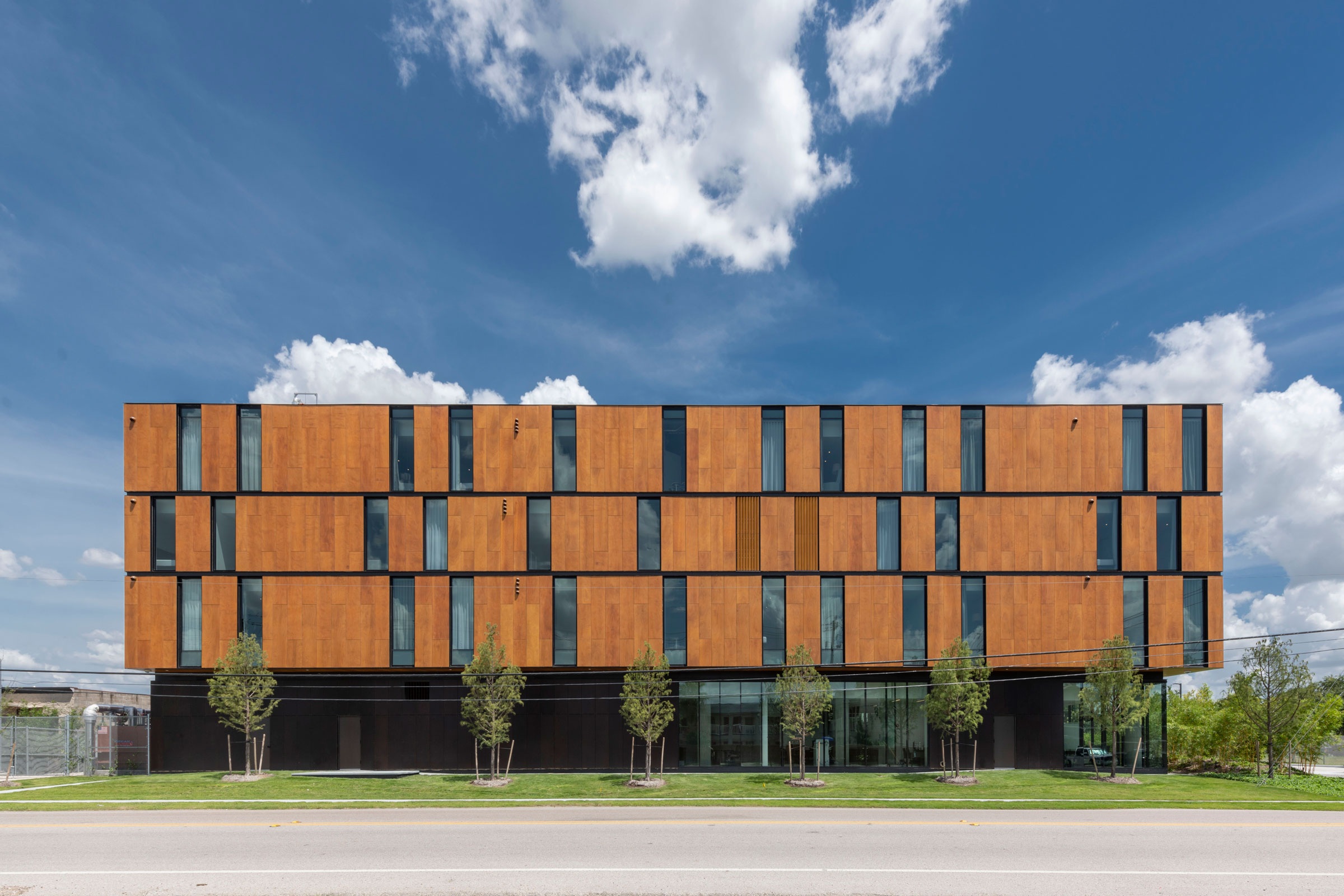
The Richard M. Schulze Family Foundation American Cancer Society, Hope Lodge in Houston (designed by Perkins & Will) provides free lodging and amenities for cancer patients undergoing treatment. Photo by James Steinkamp
Designed by Perkins&Will to the WELL Building Standard, the Richard M. Schulze Family Foundation Hope Lodge for the American Cancer Societu is a supportive home away from home for cancer patients. Here daylighting and its many benefits are on full display.
With a footprint similar to that of the traditional cloister, Hope Lodge encompasses 64,000 square feet and includes two towers wrapped around a central healing garden landscaped with native plants. All of the lodge’s communal spaces are positioned around this healing garden, giving patients access to biophilic views and flooding the interior with natural light. “As you move through the space you’re moving along this beautiful healing garden with really nice, dappled light, and that’s creating a more welcoming and comforting environment for patients and their families,” Wickard says. Biophilia is also present within the lodge’s interior in the form of exposed wood, earth-tone colors, and organic geometries that foster a deeper connection to the natural world.
Large windows are found throughout the entire facility, drastically reducing the building’s energy consumption and providing patients with much-needed vitamin D, which plays a large role in regulating the immune system and improving mental health. “It can reduce symptoms of depression and anxiety and enhance your mental alertness and focus. Another idea the building standard addresses is how important daylight is on your body’s circadian rhythm, and how that ultimately impacts your immune response,” says Wickard. Advanced water filtration and air cleaning systems further serve to provide patients with a healthy indoor environment.
4. Taussig Cancer Center, Cleveland
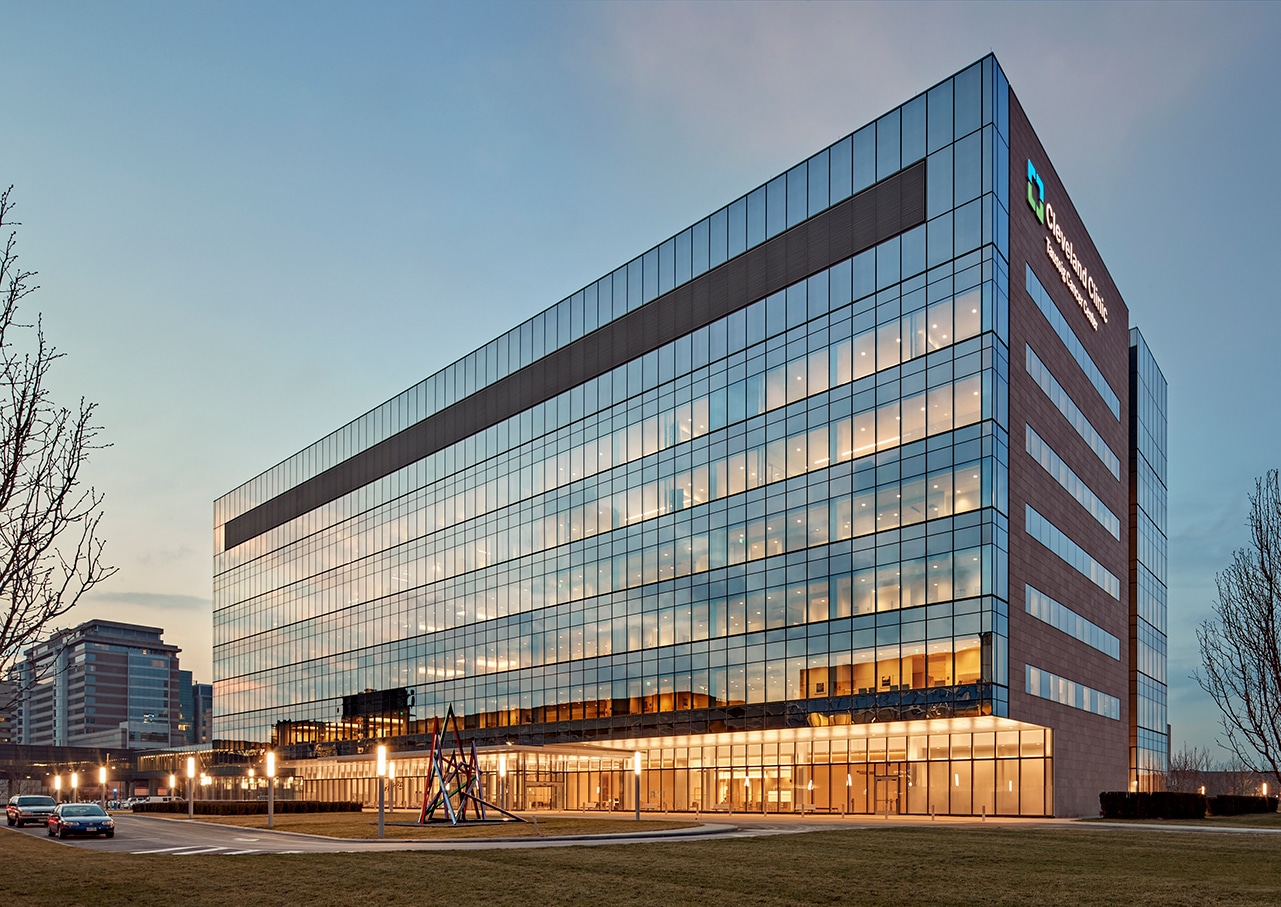
Cleveland Clinic takes a holistic approach to design for patients’ well-being. Photo by Robert Benson Photography
Designed by William Rawn Associates in collaboration with Stantec, the 377,000-square-foot Taussig Cancer Center in Cleveland is an expert example of highly sustainable, patient-centric design. The center is one of multiple health care facilities owned and operated by the Cleveland Clinic Foundation and shares the nonprofit’s holistic approach to creating simple-yet-practical medical spaces.
“Nothing is physically daunting about coming into the space,” Chris Connell, chief design officer at Cleveland Clinic’s Center for Design, previously told gb&d. “It doesn’t have to be extravagant architecture. These are very basic architecture principles that are very near and dear to our hearts but have a big impact.” Large floor-to-ceiling windows flood the interior with natural light and provide patients with a glimpse of the green courtyard outside, while airy open corridors, high ceilings, and skylights create a pleasant, welcoming, and easy-to-navigate indoor environment.
Rooms that are not able to accommodate windows due to their functionality are still well-lit by warm, welcoming ambient lighting in order to lift patient’s spirits and provide a more relaxing experience. In addition to the traditional treatment and infusion rooms, the Taussig Cancer Center also encompasses a range of other patient amenities like a cafe, meditation spaces, pharmacy, music/art therapy rooms, and more.

